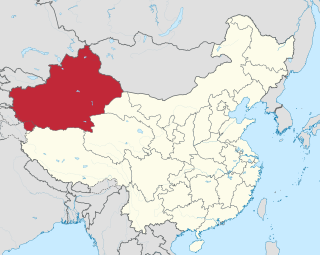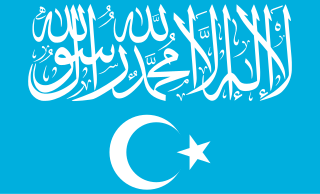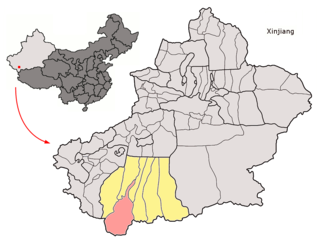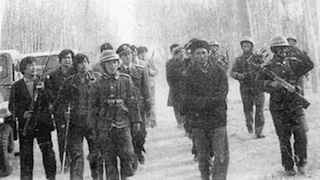Related Research Articles

East Turkestan is a loosely defined geographical and historical region in the western provinces of the People's Republic of China, which varies in meaning by context and usage. The term was coined in the 19th century by Russian Turkologists, including Nikita Bichurin, who intended the name to replace the common Western term for the region, Chinese Turkestan, which referred to the Tarim Basin in southern Xinjiang or Xinjiang as a whole during the Qing dynasty. Beginning in the 17th century, Altishahr, which means "Six Cities" in Uyghur, became the Uyghur name for the Tarim Basin. Uyghurs also called the Tarim Basin "Yettishar," which means "Seven Cities," and even "Sekkizshahr", which means "Eight Cities" in Uyghur. Chinese dynasties from the Han dynasty to the Tang dynasty had called an overlapping area the "Western Regions". The parts of this area conquered by the Manchu Qing dynasty were termed "Xinjiang" from the 18th century on.

The Turkistan Islamic Party (TIP) is a Uyghur Islamic extremist organization founded in Pakistan by Hasan Mahsum. Its stated goals are to establish an Islamic state in Xinjiang and Central Asia, and eventually a caliphate.

The East Turkestan independence movement is a political movement that seeks the independence of East Turkestan, a large and sparsely-populated region in northwest China, as a nation state for the Uyghur people. The region is currently administered as a province-level subdivision of the People's Republic of China (PRC), under the official name Xinjiang Uygur Autonomous Region (XUAR). Within the movement, there is widespread support for the region to be renamed, since "Xinjiang" is seen by independence activists as a colonial name. "East Turkestan" is the best-known proposed name as it is the historical geographic name of the region and the name of the two independent states that briefly existed in the region in the first half of the 20th century.

The East Turkestan Liberation Organization (ETLO) was a secessionist Uyghur organization that advocated for an independent Uyghur state named East Turkestan in the Western Chinese province known as Xinjiang. The organization was established in Turkey in 1990 or 1996 to fight against the Chinese government in Xinjiang, a territory of ethnic Uyghur majority. ETLO is a designated terrorist organization by the governments of China, Kazakhstan, and Kyrgyzstan.

Hasan Mahsum, also known as Abu-Muhammad al-Turkestani and Ashan Sumut, was the leader of the Islamic extremist group Turkistan Islamic Party and suspected of having ties with Al Qaeda. He was shot dead in a counter-terrorism operation on October 2, 2003 by the Pakistani Army.

The January 2007 Xinjiang raid was carried out on January 5, 2007, by Chinese paramilitary police against a suspected East Turkestan Islamic Movement (ETIM) training camp in Akto County in the Pamir plateau.
Terrorism in China refers to the use or threatened use of violence to effect political or ideological change in the People's Republic of China. The definition of terrorism differs among scholars, between international and national bodies and across time and there is no legally binding definition internationally. In the cultural setting of China, the term is relatively new and ambiguous.

The 2008 Kashgar attack occurred on the morning of 4 August 2008, in the city of Kashgar in the Western Chinese province of Xinjiang. According to Chinese government sources, it was a terrorist attack perpetrated by two men with suspected ties to the Uyghur separatist movement. The men reportedly drove a truck into a group of approximately 70 jogging police officers, and proceeded to attack them with grenades and machetes, resulting in the death of sixteen officers.

The World Uyghur Congress (WUC) is an international organization of exiled Uyghur groups that claims to "represent the collective interest of the Uyghur people" both inside and outside of the Xinjiang Uyghur Autonomous Region of the People's Republic of China. The World Uyghur Congress claims to be a nonviolent and peaceful movement that opposes what it considers to be the Chinese "occupation" of 'East Turkestan' and advocates rejection of totalitarianism, religious intolerance and terrorism as an instrument of policy. The Congress is funded in part by the National Endowment for Democracy or NED of the United States. It has been designated as a terrorist organization by China since 2003 for conspiring with separatists and religious extremists to plan terror attacks.

The 2011 Hotan attack was a bomb-and-knife attack that occurred in Hotan, Xinjiang, China on 18 July 2011. According to witnesses, the assailants were a group of 18 young Uyghur men who opposed the local government's campaign against the burqa, which had grown popular among older Hotan women in 2009 but were also used in a series of violent crimes. The men occupied a police station on Nuerbage Street at noon, killing two security guards with knives and bombs and taking eight hostages. The attackers then yelled religious slogans, including ones associated with Jihadism, as they replaced the Chinese flag on top of a police station with another flag, the identity of which is disputed.

The 2011 Kashgar attacks were a series of knife and bomb attacks in Kashgar, Xinjiang, China on July 30 and 31, 2011. On July 30, two Uyghur men hijacked a truck, killed its driver, and drove into a crowd of pedestrians. They got out of the truck and stabbed six people to death and injured 27 others. One of the attackers was killed by the crowd; the other was brought into custody. On July 31, a chain of two explosions started a fire at a downtown restaurant. A group of armed Uyghur men killed two people inside of the restaurant and four people outside, injuring 15 other people. Police shot five suspects dead, detained four, and killed two others who initially escaped arrest.

The Barin uprising or Barin riot was an armed conflict between Uyghur militants and Chinese government forces from 4 to 10 April 1990 in the township of Barin in Xinjiang, China. Violence began on the evening of 4 April, when a group of 200 to 300 Uyghur men attempted to breach the gates of the local government office in a protest against forced abortions of Uyghur women and Chinese rule in Xinjiang. The arrival of 130 armed police to quell the unrest was immediately met with armed resistance by militants among the crowd. Initial clashes that evening left six policemen dead and 13 wounded. The militants also captured five policemen, while the armed police captured 19 militants.
The 2012 Yecheng attack was a terrorist attack by Uyghur separatist extremists that occurred on February 28, 2012, in Yecheng, Xinjiang, a remote town situated about 150 miles from China's border with Pakistan. Details of the attack are disputed: according to Chinese government reports and court documents, at around 6 p.m. that day, a group of eight Uyghur men led by religious extremist Abudukeremu Mamuti attacked pedestrians with axes and knives on Happiness Road. Local police fought with the attackers, ultimately killing all and capturing Mamuti. State-run media reported that one police officer died and four police were injured, while 15 pedestrians died from Mamuti's assault and 14 more civilians were injured. Chinese officials characterized the event as a "terrorist attack."

The Xinjiang conflict, also known as the East Turkistan conflict, Uyghur–Chinese conflict or Sino-East Turkistan conflict, is an ongoing ethnic geopolitical conflict in what is now China's far-northwest autonomous region of Xinjiang, also known as East Turkistan. It is centred around the Uyghurs, a Turkic ethnic group who constitute a plurality of the region's population.
On 26 June 2013, rioting broke out in Shanshan County, in the autonomous region of Xinjiang, China. 35 people died in the riots, including 22 civilians, two police officers and eleven attackers.
Events in the year 2014 in China.
On the early morning of Wednesday, 30 July 2014, Juma Tahir, the imam of China's largest mosque, the Id Kah Mosque in northwestern Kashgar, was stabbed to death by three young male Uyghur extremists. Religious leaders across denominations condemned the attack.
Abdullah Mansour is a leader of the Turkistan Islamic Party, an Islamic and Uyghur separatist organization founded by militants in western China, the Xinjiang region. Its stated goal is the independence of East Turkestan. The group is active in the ongoing Xinjiang conflict. Between 2008 and 2013 Mansour was an editor of his movements quarterly publication Islamic Turkistan, before rising to its leadership.

The East Turkistan Government-in-Exile is a parliamentary-based exile government established and headquartered in Washington, D.C. by Uyghurs, Kazakhs, and other peoples from East Turkistan (Xinjiang). The ETGE claims to be the sole organ representing East Turkistan and its people on the international stage.
The Yarkand Massacre was an episode of violence that began on 28 July 2014 in Yarkant County, Kashgar Region of the Xinjiang Uyghur Autonomous Region, China, and lasted for several days, as Chinese police quelled the local unrest. While Chinese state media reported a few dozen fatalities, independent estimates range from hundreds to thousands.
References
- 1 2 3 Kang, Benjamin (29 October 2013). "China suspects Tiananmen crash a suicide attack- sources". Reuters. Retrieved 30 October 2013.
- 1 2 3 Kaiman, Jonathan (25 November 2013). "Islamist group claims responsibility for attack on China's Tiananmen Square". The Guardian.
- 1 2 3 4 5 6 7 "Tiananmen crash: China police 'seek Xinjiang suspects'". BBC News Online. 29 October 2013. Retrieved 29 October 2013.
- 1 2 3 4 5 "Chinese police say Tiananmen Square crash was 'premeditated, violent, terrorist attack". Washington Post. Associated Press. 30 October 2013. Retrieved 3 March 2014.
- ↑ "Tongue Tied: Education in Xinjiang". The Economist. 27 June 2015. ISSN 0013-0613 . Retrieved 15 November 2016.
- ↑ "China police call Tiananmen Gate suicide attack an act of terrorism, arrest 5 suspects". Washington Post. Associated Press. 31 October 2013. Archived from the original on 30 October 2013. Retrieved 31 October 2013.
- ↑ Wen, Philip (25 November 2013). "Turkestan Islamic Party Islamist group warns of more attacks such as Tiananmen". The Sydney Morning Herald.
- 1 2 "China names Tiananmen Square car crash 'suspects'". Times of India . 29 October 2013. Retrieved 29 October 2013.
- 1 2 "Beijing Looks for Uighur Link After Tiananmen Fireball". TIME magazine. 29 October 2013. Retrieved 29 October 2013.
- ↑ "China executes eight, including Tiananmen attackers". BBC. 24 August 2014. Retrieved 29 August 2015.
- 1 2 Bodeen, Christopher (1 November 2013). "China: East Turkestan movement behind deadly crash". Bigstory.ap.org. Archived from the original on 10 November 2014. Retrieved 5 November 2013.
- 1 2 Andrew Jacobs (3 November 2013). "China Strips Army Official of Position After Attack". The New York Times.
- ↑ "China police hunt Beijing explosion suspects". Al Jazeera . 29 October 2013. Retrieved 29 October 2013.